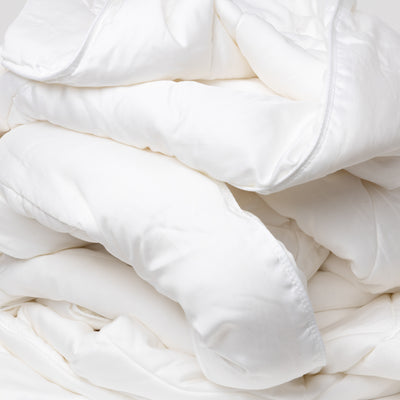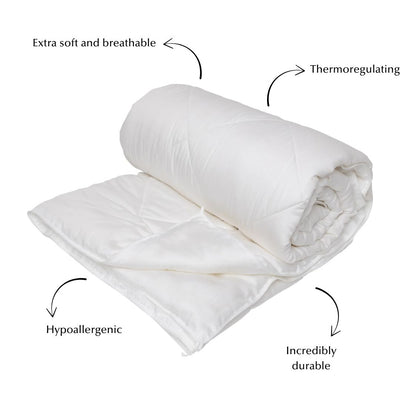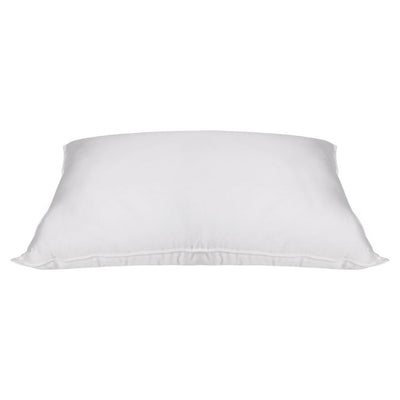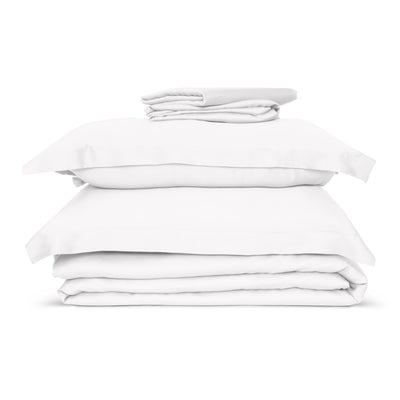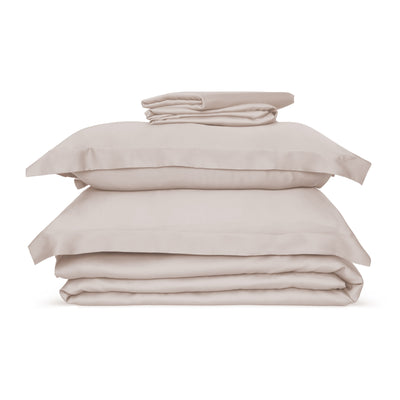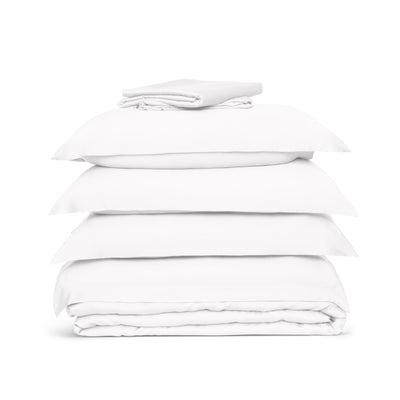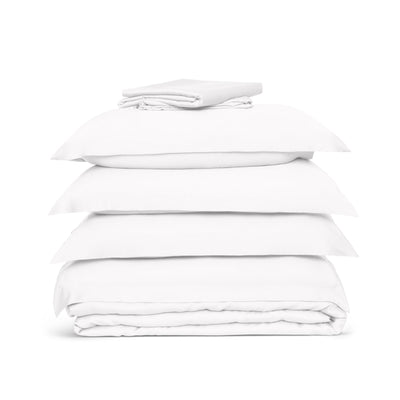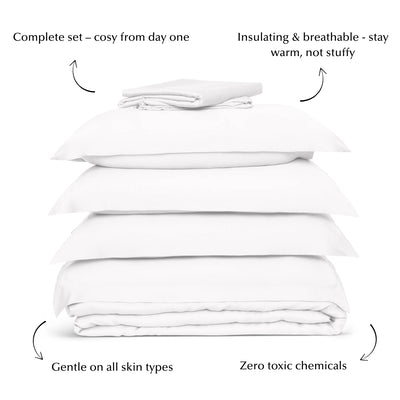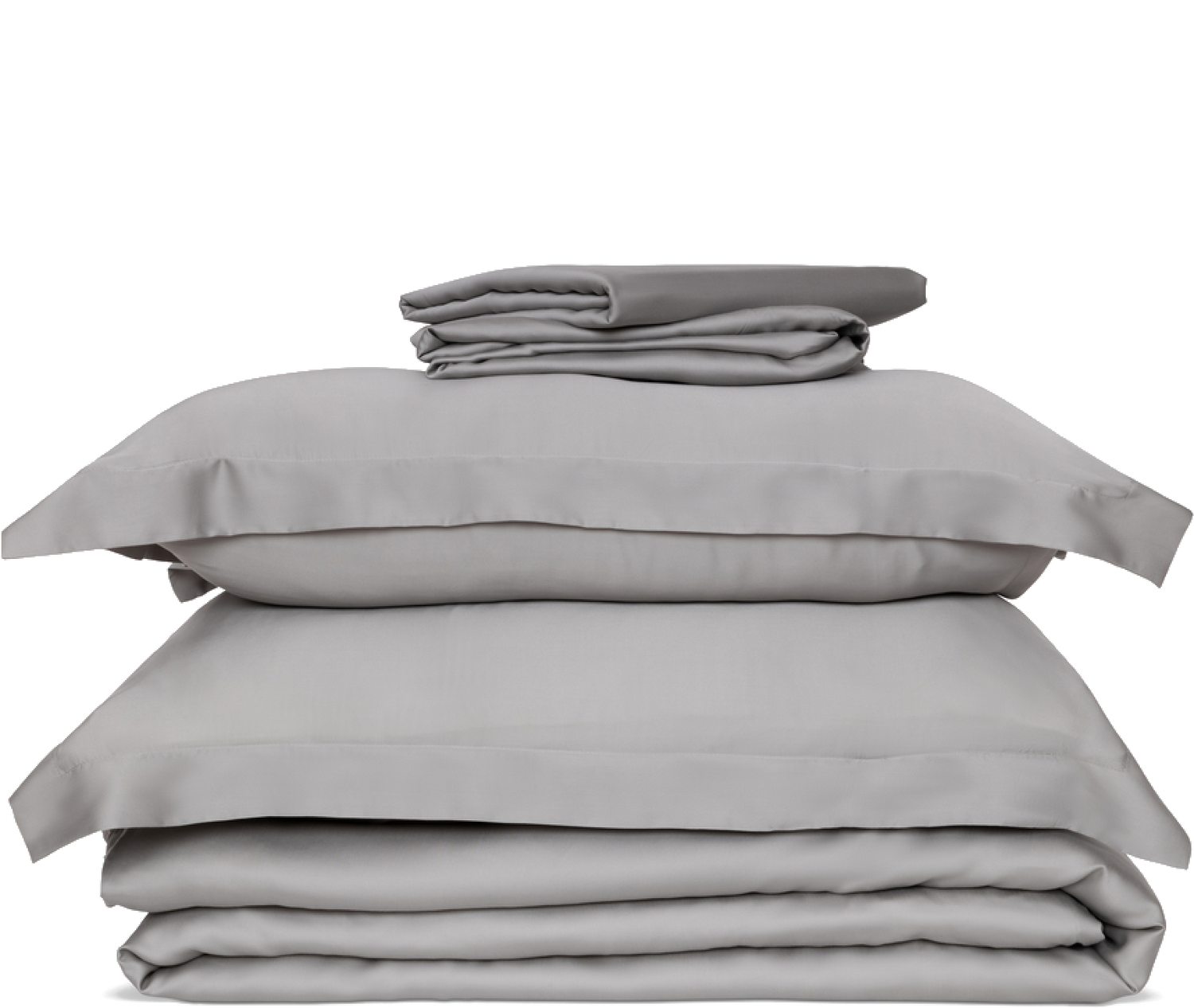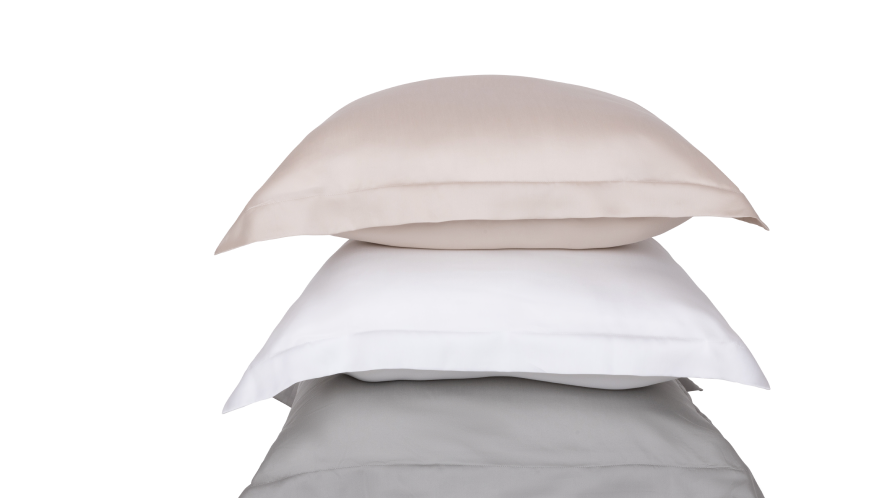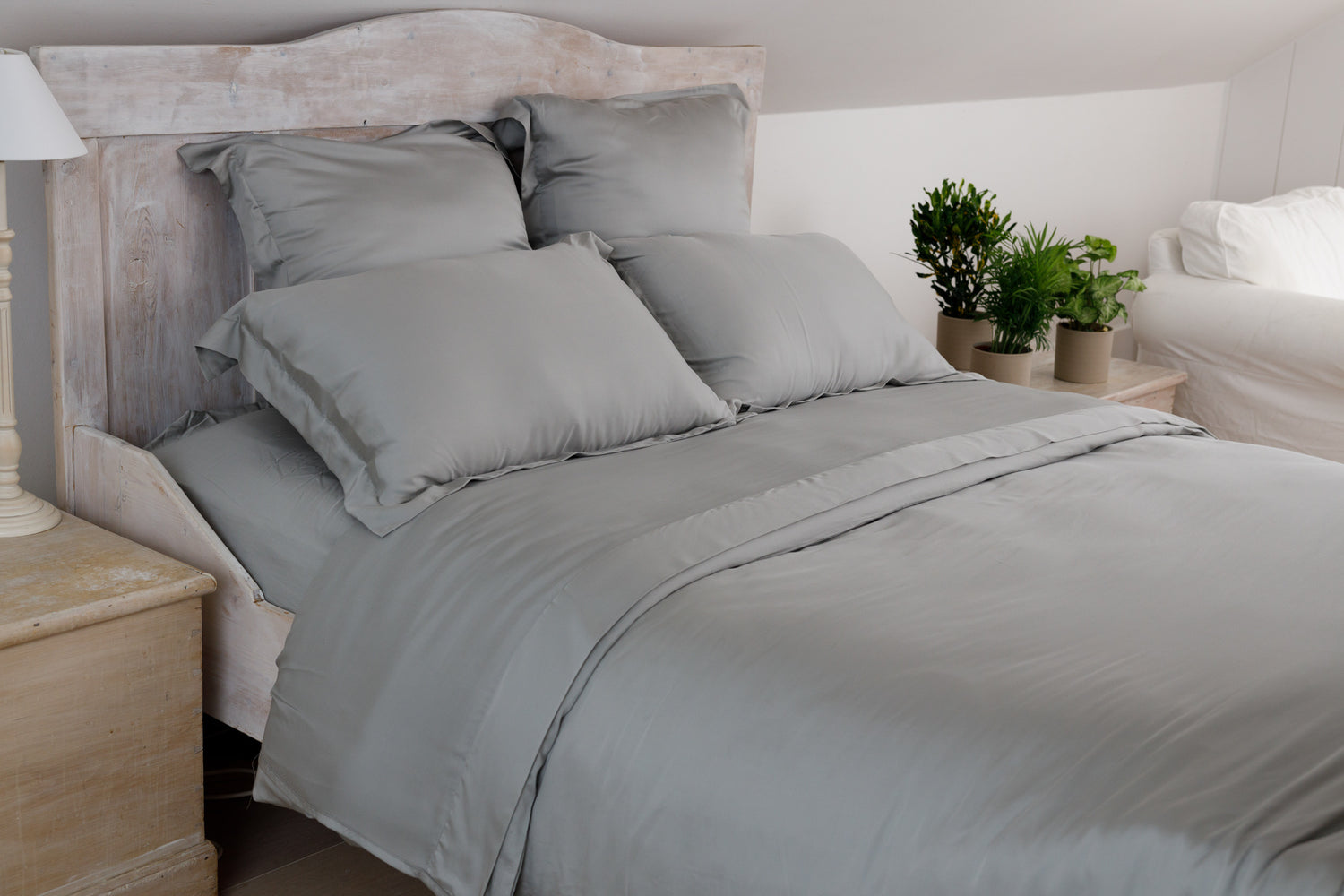Stained and discoloured sheets are all too common and can seriously impact the appearance of your white bedding. However, fortunately, there are straightforward ways of returning your sheets to their pristine condition.
In this article, we’ve explained why sheets turn yellow, how to get stains out of white bed sheets, how to prevent sheets from becoming discoloured, and identified bed sheets that don’t turn yellow in the first place. So, without further ado, read on to find out how to get rid of yellow-stained bed sheets!
Why do sheets turn yellow?
There are a number of reasons why your sheets may begin to turn yellow, but discolouring doesn’t necessarily mean you’re unclean or hygienic. On the contrary, in fact. It’s completely normal to see yellowing after a period of use, with common causes including anything from sweat, bodily fluids, and natural oils to creams, lotions, and other skincare products.
It's worth noting that, while you might only start to notice yellow stains as though they’ve appeared overnight, it’s likely that the discolouring is the result of a build-up of sweat or oils over time.
With so many factors that could potentially contribute to yellow-stained sheets, discolouring is perhaps unsurprisingly something countless people face each day. Fortunately, there are a series of simple solutions to save your sheets from yellow stains that we’ve delved into below.
How to get yellow stains out of white sheets?
Discoloured bedding is completely normal, and something everyone is likely to encounter at some point or another. To help you take control, we’ve outlined five common ways of removing yellow stains from sheets.
Borax
Borax is a popular favourite when it comes to household stains and odours and can be used to whiten your bed sheets. You’ll need a little forward planning, but you can remove yellow stains with borax by:
- Mixing 125ml of borax with a gallon of water (you can use a deep basin or the bathtub).
- Soaking your sheets in the borax solution overnight.
- Spinning your bed sheets in the washing machine as usual.
Vinegar and baking soda
A couple of common household items; vinegar and baking soda work a treat if you’re trying to get rid of pesky yellow stains. However, it’s not just a case of mixing them up in your washing machine. To whiten your sheets with vinegar and baking soda, you need to:
- Add half a cup of baking soda to the drum of your washing machine with your laundry.
- Add a splash of white vinegar to the fabric softener compartment of your machine.
- Spin your bed sheets in the machine as usual.
Lemon juice
Lemon juice is an effective agent against yellow stains, because of the presence of citric acid. Citric acid is a natural bleach that helps to breathe new life into your bedding without having to use harmful chemicals. Plus, you’ll give your sheets a soft, lemony smell.
To wash your sheets using lemon juice, simply pour the juice of one lemon into your washing machine with your bedding and regular non-toxic detergent. Then, spin your sheets as usual.
Hydrogen peroxide
Hydrogen peroxide is another common cleaning solution, and a popular pick when it comes to removing yellow-stained sheets. While it’s considered safe to use, it’s important to stick to a couple of basic safety principles:
- Avoid mixing with vinegar, as you could create an acidic irritant that makes your bed sheets uncomfortable to sleep on.
- Avoid mixing with bleach, as this could lead to an explosive chemical reaction.
To clean your bedding, all you need to do is add a cup of hydrogen peroxide to your next wash, and spin as usual. And if you’re encountering persistent stains, combine with baking soda for an extra-powerful scrub.
Liquid bluing
Something you may have heard of, but have little idea as what it actually is, is liquid bluing. Essentially, this refers to adding a bluish pigment to your sheets, to counteract the yellow staining. Though the name suggests it’s only available in liquid form, you can often also find the blue pigment as a powder, so you can choose the application you’re most comfortable with. All you need to do is:
- Mix a splash of the pigment with a gallon of water (this is important, as applying directly to your sheets will be overwhelming and stain your bedding).
- Pour the mixture into your washing machine with your regular non-toxic detergent.
- Spin your bed sheets in the machine as usual.
How to prevent yellow stains on white sheets?
Of course, while it’s useful to know how to remove yellow stains from bedding, it’s even more helpful to have a string of prevention techniques to reduce the chance of discolouring happening again. The simplest ways to prevent yellow stains on white bed sheets include:
Wash them regularly
It might sound like a simple hack, but regularly washing your bed sheets will reduce the chance of yellow staining. And by regularly, we mean once a week (unless the washing instructions suggest otherwise). After all, the discolouring is likely a result of the long-term impact of sweat, lotions, and oils, so running your sheets through a weekly wash will hit the source before it becomes a problem and prevent a build-up.
Avoid using bleach
While it may be the first thing you think of when you see a stubborn stain, it’s actually best to avoid using bleach to whiten your sheets. This is because bleach can react to the bodily liquids and oils present in the bedding and cause further damage or enhance the yellowing. What’s worse is that the bleach-stain will now be even tougher to remove, if not impossible.
Avoid eating in bed
Of course, bodily oils aren’t the only cause of discoloured bedding. Food and drink spillages are also common reasons for Brits having to put their bedding through the wash more often than they’d like. Although it might sound impractical, the straightforward solution here is to avoid eating in bed where possible, or at least putting your plates and bowls on a tray to catch any stray spills.
Avoid fabric softeners
Though it may be tempting to use fabric softeners to give your bedding a luxury feel, be aware that doing so incorrectly could contribute to yellow stains and discolouring: namely, adding too much softener to your wash. To stay on the safe side, it’s best to avoid fabric softeners, or choose bedding that remains soft and silky after every regular wash (more on this below).
Change your nightly routine
One of the main causes of yellow stains is night time sweating, but you may also be transferring dirt from throughout the day. To combat this, it can be good to get into the habit of showering on an evening before getting under the duvet, to limit the amount of grime you’re bringing into bed. It’s also useful to get into the habit of washing your face at bedtime, to limit the amount of oils you’re transferring to your pillows.
Bed sheets that don’t turn yellow
While it’s not necessarily the most taxing chore, going through the process of preventing and resolving yellow sheets can quickly become quite tiresome – especially if you’re regularly having to forward-plan to remove stubborn stains.

But did you know there are actually flat and fitted bed sheets that are specially designed to combat stains and odours, while remaining luxuriously soft and silky? In fact, eucalyptus silk bed sheets are:
- Moisture wicking: effective moisture management means your sheets wick away you’re your sweat as you sleep, creating a dry environment that’s hostile towards bacteria and mould. This means your sheets stay fresher for longer.
- Temperature regulation: eucalyptus bed sheets naturally adapt to your body temperature, meaning you’ll always be cool and comfortable, no matter the season – including those hot summer nights. This reduces the amount of sweat you produce at night, which in turn limits the chance of yellow staining.
- Breathability: the highly breathable textiles used in the manufacturing of eucalyptus sheets means you’re less likely to suffer from night sweats, which naturally reduces the chance of yellow staining.
But not only that: eucalyptus silk is also a highly ethical material, sourced from the fast-growing and sustainable eucalyptus tree. So, not only will you enjoy soft and silky fitted or flat bed sheets that keep you comfortable all night long, but you’ll be helping the planet along the way.
Tips for washing and storing white sheets
Finally, to make sure you’re fully clued up when it comes to looking after your crisp white sheets, even after removing yellow stains, we’ve pulled together some final thoughts about washing and storing your bedding.
1. Wash white sheets weekly
To keep your bed sheets in the best possible condition, it’s handy to wash them weekly – unless, of course, the fabric requires fewer washes, such as eucalyptus silk. Not only does this attack evident and stubborn staining, but it also allows you to combat bacteria, grime, and dirt before it even has a chance to discolour your sheets.
2. Don't overstuff the washing machine
If you have a lot of dirty bedding and laundry, it can be tempting to throw it all in the washing machine together. However, while you might assume you’re washing more at once, this is actually relatively ineffective. In fact, overstuffing your washing machine means all your laundry will simply move around as one, rather than allowing soapy water to freely run through and clean stains and odours.
3. Be mindful of dye transfer
Whenever you’re dealing with dye, always be mindful that if not handled correctly, you could end up staining your sheets even more! With this in mind, rather than applying it directly, it’s typically advised that you dilute your dye in water.
4. Measure laundry products carefully
When washing, it’s perhaps reasonable to assume that the more detergent you use, the cleaner your laundry. However, this isn’t always the case. In fact, using too much product can actually leave residue, which may even contribute to the quicker deterioration of your bed sheets.
5. Make use of the extra rinse cycle
If you’re concerned about particularly stubborn stains, yellowing, or discolouring, it can be useful to make use of the extra rinse cycle feature on your washing machine. If this isn’t actively available, you can manually run a rinse after the main wash, to make sure you’re getting rid of as much dirt and grime as possible.
6. Dry in the sunshine
Drying your bedding in the sunlight is an effective way of getting rid of persistent germs and odours. This is because the ultraviolet light that comes from the sun is a natural disinfectant, and acts as a final antibacterial clean.
For many people, discoloured bedding is completely natural and nothing to be concerned about. However, knowing how to get rid of and prevent yellow stains can help to extend the lifespan of your sheets.
If you’ve found this interesting, for even more insight from our team of sleep experts, check out the latest over on the Ethical Bedding blog, including the things to consider when buying new bed sheets and the differences between flat and fitted sheets.

